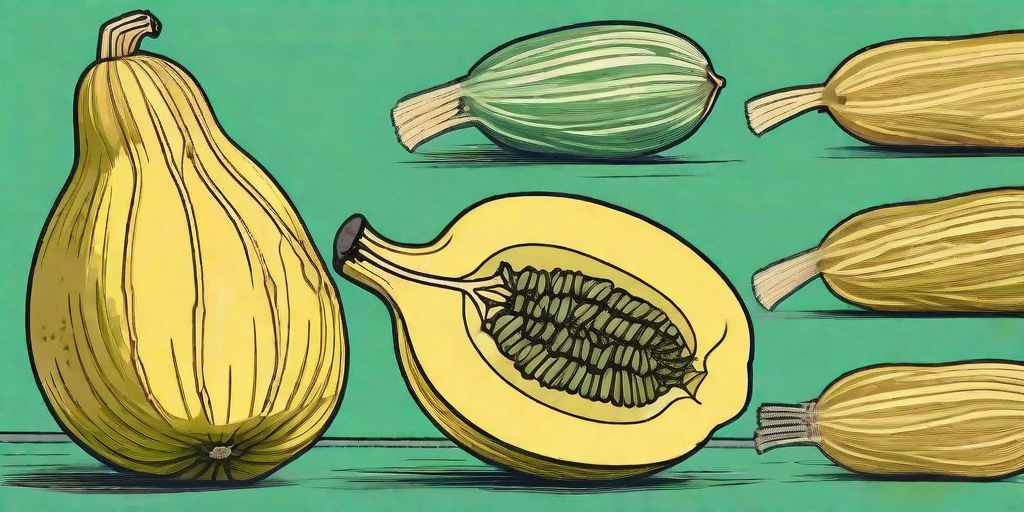
Welcome to the world of spaghetti squash, a magical place where vegetables masquerade as pasta and your culinary skills can truly shine. If you're new to this intriguing gourd, don't worry. We're here to guide you through the labyrinth of spaghetti squash mastery, starting with the most fundamental question: how to determine its ripeness.
Understanding the Spaghetti Squash
Before we delve into the intricacies of ripeness, let's take a moment to appreciate the spaghetti squash in all its glory. This winter squash variety, also known as vegetable spaghetti, noodle squash, or squaghetti (yes, squaghetti), is a marvel of nature. When cooked, its flesh separates into strands that resemble spaghetti, hence the name.
With its mild flavor and versatile texture, spaghetti squash is a darling of the culinary world. It's a low-carb, gluten-free alternative to pasta, making it a favorite among health enthusiasts and those with dietary restrictions. But enough of the fanfare, let's get down to business.
Identifying a Ripe Spaghetti Squash
Choosing a ripe spaghetti squash is akin to picking a lock. It requires patience, attention to detail, and a little bit of cheeky intuition. But don't worry, we've got a foolproof guide to help you crack the code.
First and foremost, color is key. A ripe spaghetti squash is a vibrant yellow or golden color. If it's green or white, it's not ready for the spotlight yet.
Weight Matters
Next, consider the weight. A ripe spaghetti squash should feel heavy for its size. This is because it's packed full of delicious, noodle-like flesh. If it feels light or hollow, it's likely underripe.
But don't just take our word for it. Give it a good heft. Pretend you're auditioning for the role of a robust Italian chef in a Hollywood movie. If it feels substantial, you're on the right track.
Inspect the Skin
Now, let's talk about the skin. A ripe spaghetti squash has a hard, tough skin. If you can easily pierce it with your fingernail, it's not ready.
Also, look for a uniform color without any dark spots or blemishes. These could indicate that the squash is overripe or damaged.
Storing Your Spaghetti Squash
Once you've selected the perfect spaghetti squash, it's time to consider storage. Proper storage can extend the life of your squash and ensure it's ready when you are.
Spaghetti squash should be stored in a cool, dry place. Avoid refrigeration, as this can cause it to become mushy and lose its flavor.
Shelf Life
When stored properly, a whole spaghetti squash can last for up to a month. Once cut, it should be used within a week.
Remember, the key to longevity is to keep your squash cool, dry, and happy. Treat it like a treasured guest, and it will reward you with delicious meals.
Preparing Your Spaghetti Squash
Now that you've mastered the art of selecting and storing spaghetti squash, it's time to prepare it. This is where the real fun begins.
Spaghetti squash can be baked, boiled, steamed, or microwaved. The method you choose depends on your personal preference and how much time you have.
Baking
Baking is a popular method because it brings out the natural sweetness of the squash. To bake a spaghetti squash, cut it in half lengthwise, remove the seeds, drizzle with olive oil, and bake at 375°F for about 40 minutes.
Once it's done, use a fork to scrape out the spaghetti-like strands. Voila! You have a delicious, healthy alternative to pasta.
Boiling
Boiling is a quicker method, but it can result in a slightly watered-down flavor. To boil a spaghetti squash, cut it into chunks, remove the seeds, and boil for about 20 minutes.
Again, use a fork to separate the strands. Be careful, though. The squash will be hot!
Frequently Asked Questions
Can I eat spaghetti squash raw?
While technically you can eat spaghetti squash raw, it's not recommended. The raw flesh is hard and lacks the spaghetti-like texture that makes this squash so unique.
Can I ripen spaghetti squash off the vine?
Unfortunately, spaghetti squash does not continue to ripen once it's been harvested. This is why it's so important to choose a ripe squash at the store.
What can I do with overripe spaghetti squash?
If your spaghetti squash is overripe, it may be too soft to create the spaghetti-like strands. However, you can still use it in soups or purees.
Conclusion
Mastering the art of spaghetti squash is a journey, not a destination. With practice, patience, and a dash of humor, you can become a spaghetti squash connoisseur.
So go forth, brave culinary explorers. The world of spaghetti squash awaits.











